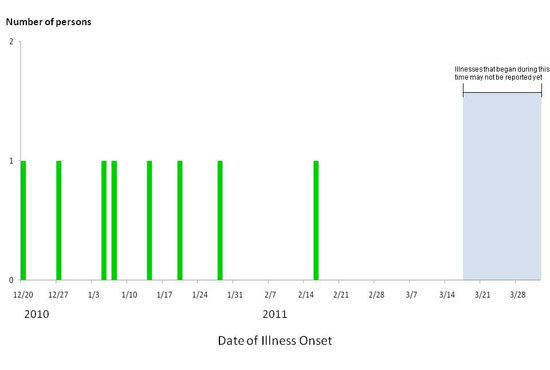2011 E. coli Outbreak Linked to In-Shell Hazelnuts
NOTICE: This outbreak is over. The information on this page has been archived for historical purposes only and will not be updated.
Posted April 7, 2011
Outbreak Summary
CDC collaborated with public health officials in California, Michigan, Minnesota, Wisconsin, and the U.S. Food and Drug Administration (FDA) to investigate a multistate outbreak of E. coli O157:H7 infections. Investigators used DNA analysis of E. coli O157:H7 bacteria obtained through diagnostic testing to identify cases of illness that may have been part of this outbreak.
As of April 1, 2011, eight persons infected with the outbreak strain of E. coli serotype O157:H7 were reported from Michigan (1), Minnesota (3), and Wisconsin (4). Reported dates of illness onset range from December 20, 2010 to February 16, 2011. Ill persons ranged in age from 15 to 78 years, with a median age of 63 years; 75% were male. Among ill persons, 50% reported being hospitalized, and none reported hemolytic uremic syndrome, which is a type of kidney failure that is associated with E. coli O157:H7 infections. No deaths were reported.
The outbreak can be visually described with a chart showing the number of people who became ill each day. This chart is called an epidemic curve or epi curve. This outbreak appears to be over. However, illnesses that occurred after March 17, 2011, might not be reported yet due to the time it takes between when a person becomes ill and when the illness is reported. This takes an average of 2 to 3 weeks. Please see the Timeline for Reporting Cases of E. coli O157 Infection for more details.
Investigation of the Outbreak
Collaborative investigative efforts of local, state, and federal public health and regulatory agencies associated this outbreak with eating in-shell hazelnuts (also known as filberts). Most of the in-shell hazelnuts were purchased from bulk bins at retail food stores. Source tracing identified a common distributor for the hazelnuts consumed by ill persons: DeFranco & Sons in Los Angeles, California. Laboratory testing conducted by the Minnesota Department of Agriculture on in-shell hazelnuts, the California Department of Public Health on mixed nuts containing in-shell hazelnuts, and the Wisconsin Department of Agriculture, Trade and Consumer Protection and Wisconsin Department of Health Services on mixed nuts containing in-shell hazelnuts identified E. coli O157:H7 matching the outbreak strain by DNA analysis.
Recall Information
DeFranco & Sons of Los Angeles, CA voluntarily recalled bulk and consumer-packaged in-shell hazelnuts and mixed-nut products containing hazelnuts. These nuts may have been sold by retailers nationwide. The in-shell nuts may have been sold in two-pound and four-pound packages of mixed nuts, one-pound packages containing only hazelnuts, or in open bins of nuts in grocery stores. Consumers are advised to review the DeFranco press release for a list of recalled products.
Clinical Features/Signs and Symptoms
Most people infected with E. coli O157:H7 develop diarrhea (often bloody) and abdominal cramps 2-8 days (3-4 days, on average) after swallowing the organism, but some illnesses last longer and are more severe. Infection is usually diagnosed by stool sample culture. While most people recover within a week, some develop a severe infection. A type of kidney failure called hemolytic uremic syndrome (HUS) can begin as the diarrhea is improving; this condition can occur among persons of any age but is most common in children under 5 years old and the elderly. Signs and symptoms of HUS may include fever, abdominal pain, pale skin tone, fatigue and irritability, small, unexplained bruises or bleeding from the nose and mouth, decreased urination and swelling of the face, hands, feet, or entire body. Persons who experience these symptoms and believe they are at risk for HUS should seek emergency medical care immediately.
Advice to Consumers, Retailers, and Others
Consumers should not eat any of the recalled products, and restaurants and food service operators should not serve them. Consumers, retailers, and others who have any of the recalled products should dispose of them in a closed plastic bag placed in a sealed trash can. This will prevent people or animals from eating them.
CDC’s Role in Food Safety
CDC leads federal efforts to gather data on foodborne illnesses, investigate foodborne illnesses and outbreaks, and monitor the effectiveness of prevention and control efforts. CDC is not a food safety regulatory agency but works closely with the food safety regulatory agencies, in particular, with FDA and FSIS. CDC also plays a key role in building state and local health department epidemiology, laboratory, and environmental health capacity to support foodborne disease surveillance and outbreak response. Notably, CDC data can be used to help document the effectiveness of regulatory interventions.
Additional Resources
- FDA press release
- California Department of Public Health press release
- Minnesota Department of Health press release
- DeFranco and Sons Recalls Hazelnuts and Mixed Nuts with Hazelnuts Due to Possible Health Risk
- E. coli Resources for Clinicians
- FoodSafety.gov
Final Case Count Map
Persons infected with the outbreak strain of E. coli O157:H7, by state, as of April 1, 2011 (n=8)

As of April 1, 2011, eight persons infected with the outbreak strain of E. coli serotype O157:H7 were reported from Michigan (1), Minnesota (3), and Wisconsin (4).
Final Epi Curve
Persons infected with the outbreak strain of E. coli O157:H7, by date of illness onset*

*n=8 for whom information was reported as of April 1, 2011